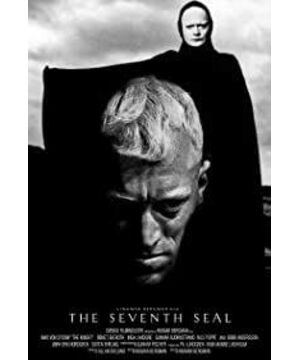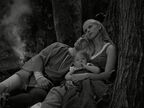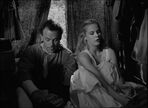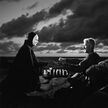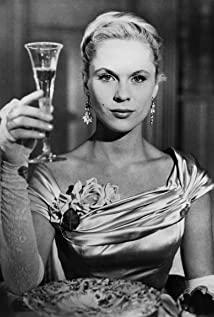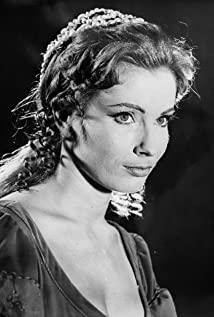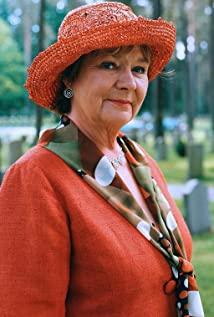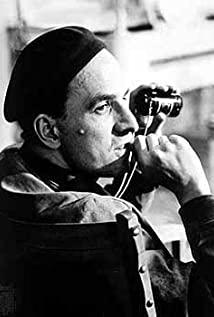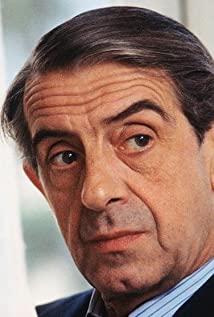Ingmar Bergman is influenced by the two cornerstones of modern Western civilization: the Greek civilization and the Hebrew civilization. The projection of the former on him is the dream of the Sun God and the drunkenness of the Dionysian, and the projection of the latter on him It is the original sin of Christianity, introspection, and punishment. These elements are reflected in this book.
When we pulled up the curtain to open the movie, we couldn't help but be attracted by the beginning of the movie. The dark and majestic vocal chorus and the exploding clouds behind the eagle's view of the earth gave the movie a solemn tone. "When the Lamb opened the seventh seal, there was silence in the sky for about two moments." This is the source of the title of the movie, and it also sets a silent tone for the whole text. The original text is from "New Testament: Revelation". Friends who have learned about the "Bible" out of interest may find it strange, because "silence" is actually a rare symbol in Hebrew culture. The people in the "Bible" Prayer dances, God's gospel mercy, and God's punishment to create the world are mostly grand and enthusiastic, because the overall tendency of Hebrew culture is dynamic, dynamic, and even bursting. Bergman chose language symbols from the Bible, but with an anti-Biblical color, which were both the title of the film and the opening narration in brisk Swedish, showing the continuity of Bergman's "turbulent agitation in silence". sexual style.
The scene that emerges with the narrator is a dead beach, and the people who fall on the ground do not know whether they are alive or dead. The huge chessboard standing on the rocks gives people a sense of absurdity that time and space are not unified. The chessboard itself is a symbol of the game. Who will play against whom, and what is he looking for? The protagonist, the knight in Crusader armor, stood up and prayed, and his opponent, Death in black and white, waited silently among the rubble. From their dialogue, we know the basic conflict of the film. Death came here to ask for his life, but the knight wanted to find life for himself by playing chess. his shadow. The knight wakes up the squire who fell on the beach and goes on the road, the camera zooms out, and the narrative of the film advances slowly. The image of the god of death is worth considering, because there is only one god in the Christian worldview, and the slogan of the Crusades was to eradicate paganism and retake the Holy Land. On the other hand, the image of the god of death mostly comes from folk tales from all over the world, and it is an image that can only be derived from tavern slang and ancient fairy tales. But the knight accepted the existence of the god of death calmly, and knew why he came. We know that he still believes in the Lord whom he prayed to with his fingertips, but he no longer believes in the Lord's scriptures. This is a complicated believer. However, the director's rebellious and philosophical thinking is still behind.
Compared with the knight, the slave who follows the city has a more lively image. He rolls his eyes behind the knight, hums his own tune, is not afraid after asking for directions and encounters a dead person, and responds to the master humorously.
The two pass a carriage, and a comedian wakes up from the carriage. He is wearing heterochromatic trousers, rolling over on the grass and stretching, giving the film a warm and relaxed atmosphere. He sees the Holy Child under the support of the Virgin Mary. In the warm scene of the preschool in the forest, he smiled and was moved to tears and woke his wife to share, and also woke up their children and the actor boss. Here's a detail, actor Joseph's name coincides with the name of Jesus' adopted husband Joseph, and his wife Mia coincides with the name of the Virgin Mary. This textual message gives their images a divinity in the film, and Joseph sees miracles while practicing burlesque, suggesting that his divinity is in his daily work and life.
In addition, we cannot fail to notice that the visual differences in the first appearance of the knight and the actor are so great that they must have been carefully designed by the director. The knight slept on a hard rock, and when he woke up, he clasped his hands together and prayed silently. The scene that belonged to him was a symbol of the deep sea and a chessboard that symbolized confrontation. Their two horses were placed freely in the sea without any restraints. Beneath the sea he sees the ghastly figure of death; the actors sleep on the soft grass, wake up complaining and practice burlesque, and his scenes are the tree of life, the carriage of the family, one of their horses He was tied to a tree by a rope, but what he saw was the sweet and amiable Madonna. A theme of this film is reflected in their clustering comparison. The cornerstone of Christianity is "justification by faith." "Righteousness" is the name after the accusation against the accused in the European courts has been dropped. We can understand that "righteousness" refers to those who are saved in judgment. Of the two mentioned above, who is a believer in the religious sense? Naturally, it is the knight who gets up early to pray, but what the knight faces is death.
Some friends may think that this movie is still Bergman's last temple for religion, because the actor's family who saw the Virgin also escaped the death sentence in the end. But the students thought that the film showed the shattering of the foundation stone, and the religiousness was presented in the form of ruins, because the actors who escaped the trial were not believers in the traditional sense, but the knight who believed in the Lord finally ushered in the trial,
The next scene makes the outline of the knight more clear. The knight and the attendant arrived at a chapel. The camera first gave the attendant and the painter. The painter painted not a biblical story on the wall, but a dance of death. The artist explained that a dead head is more attractive than a woman's naked body, and the viewer thinks when he sees death. This may also tell us the audience why the director wants to design a living image of death. The director visualized and symbolized death, in order to show that for an individual, death is certain and there is no immortality in any form. Although death itself means a kind of nothingness, thinking about death allows us to question, hesitate, fear, and re-understand and love life.
So how does one understand life in the shadow of death? The director's design is so stern and perfect, he gives the answer directly in the next shot. The knight confided to the shadow in the confession room that he hoped the Lord would give him the knowledge to face the inescapable death, he questioned the shadow of life, and told the strategy of the chessboard. However, in a clever light and shadow transition, the camera reveals the true body in the shadows, and he is the opponent the knight is struggling to fight against: the god of death. His letter ultimately led to his death. The way to contact the Lord is completely cut off in the movie, and the grace of "justification by faith" has disappeared. In the face of death, disease, and pain, we can only use our own existence as a new cornerstone, in a realistic way Give yourself hope, enthusiasm, direction. Since then, human subjectivity has determined its own time-limited freedom. Other than that, there is nothing to desire.
If a friend asks me during a chat, have you seen the work of a certain Swedish director, I will hesitate and say this film.
Really, what are you talking about? A friend asked.
The believers questioned his faith after the battle, he found some, but more disease and nothingness, he was in pain, and his dance of death in the distant mountains made mortals look up.
When mortals saw miracles in his life, he was moved every time, but it was always difficult for others to see. He was very happy, and his warm life in the grass made believers look sideways and contemplate.
Is that so? Friends are silent.
I smiled and quickly turned the subject in another direction. In any case, the director's films are not perfect topics to talk about with friends
View more about The Seventh Seal reviews


